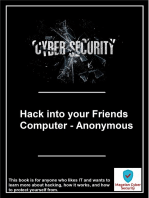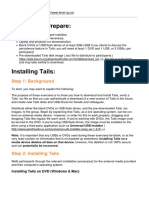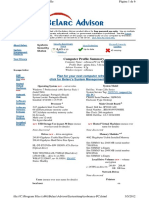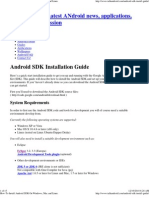How I Cracked Your Windows Password (Part 2)
How I Cracked Your Windows Password (Part 2)
Uploaded by
vijaychutarCopyright:
Available Formats
How I Cracked Your Windows Password (Part 2)
How I Cracked Your Windows Password (Part 2)
Uploaded by
vijaychutarOriginal Title
Copyright
Available Formats
Share this document
Did you find this document useful?
Is this content inappropriate?
Copyright:
Available Formats
How I Cracked Your Windows Password (Part 2)
How I Cracked Your Windows Password (Part 2)
Uploaded by
vijaychutarCopyright:
Available Formats
How I Cracked your Windows Password (Part 2) :: Authentication, Acces...
http://www.windowsecurity.com/articles-tutorials/authentication_and_en...
(http://www.windowsecurity.com)
Home
Home
Articles & Tutorials
Products
Reviews
Free Tools
Blogs
Security Tests
Forums
White Papers
Contact Us
Articles & Tutorials
Authentication, Access Control & Encryption
How I Cracked your Windows Password (Part 2)
by Chris Sanders [Published on 10 Feb. 2010 / Last Updated on 10 Feb. 2010]
Like 6 Tweet 0 3 6
Going through the process of cracking passwords with different free tolls whilst providing tips for defending your password from being cracked. If you would like to read the first part in this article series please go to How I Cracked your Windows Password (Part 1) (http://www.windowsecurity.com/articles/How-Cracked-WindowsPassword-Part1.html).
Introduction
In the first part of this series we examined password hashes and the mechanisms Windows utilizes to create and store those values. We also touched upon the weaknesses of each method and possible avenues that can be used to crack those passwords. In the second and final article in this series I will actually walk you through the process of cracking passwords with different free tools and provide some tips for defending against having your password cracked. It is always crucial to note that the techniques shown here are strictly for educational purposes and should not be used against systems for which you do not have authorization for.
Obtaining Password Hashes
In order to crack passwords you must first obtain the hashes stored within the operating system. These hashes are stored in the Windows SAM file. This file is located on your system at C:\Windows\System32\config but is not accessible while the operating system is booted up. These values are also stored in the registry at HKEY_LOCAL_MACHINE\SAM, but again this area of the registry is also not accessible while the operating system is booted. There are a few different options here depending on the level of access you have to the machine you are auditing.
(http://banman.isoftmarketing.com/a.aspx?Task=Click&ZoneID=76&CampaignID=2746&AdvertiserID=140&
BannerID=1967&SiteID=6&RandomNumber=543821606&Keywords=articlestutorialsauthenticationandencryption%2chowcrackedwindowspasswordpart2)
Physical Access
If you have physical access, one of the most effective methods is to boot the computer into a different operating system. If you are comfortable using Linux then this means you can simply boot to a Linux live CD that is capable of reading NTFS drives, mount the Windows partition, and copy the SAM file to external media. If you are not quite comfortable doing this, you can use P. Nordahls famed Offline NT Password Editor, available here (http://pogostick.net/~pnh/ntpasswd/). This is a bootable Linux distribution designed to aid system users who have forgotten their passwords by allowing them to reset them. The software takes the users input, creates a valid hash, and replaces the old hash in the SAM file with the new one. This is useful to us because we can also use the distribution to simply read the SAM file and get the hash data. In order to do this, boot from the CD image and select your system partition, the location of the SAM file and registry hives, choose the password reset option [1], launch the built in registry editor [9], browse to SAM\Domain\Account\Users, browse to the directory of the user you wish to access, and use the cat command to view the hash contained in the files. The output will be in hex format, but it works with a simple conversion.
1 of 5
3/10/2014 4:52 PM
How I Cracked your Windows Password (Part 2) :: Authentication, Acces...
http://www.windowsecurity.com/articles-tutorials/authentication_and_en...
Figure 1: Hex output of the SAM hash Before using the Offline NT Password Editor to actually reset a password, be sure that you are not using Encrypted File System (EFS) on anything released after Windows XP/2003. If you do this, it will cause the operating system to lose its EFS keys, resulting in more problems than just a forgotten password.
Console Access
If you are performing password auditing activities without physical access to the device in question, but you still have console access through remote desktop or VNC, then you can obtain password hashes through the use Fizzgigs fgdump utility, obtainable here (http://www.foofus.net/fizzgig/fgdump/). Once you have downloaded fgdump to host you can simply run it with no options to create a dump of the local machine SAM file.
Figure 2: Confirmation the Fgdump Utility Ran Correctly Once this is completed, a file will be generated in the same directory the utility was launched from that contains a list of all user accounts, their LM hashes, and their NTLMv2 hashes.
Figure 3: Password Hashes Output by Fgdump
Network Access
Finally, if you do not have any interactive access to the machine that has the hashes you want, your best bet is to attempt to sniff the hashes as they travel across the network during the authentication process. Of course, this will only work if the client is authenticating to a domain controller or accessing resources on another client, otherwise, you are more out of luck than a one armed man in a paper hanging contest. If you are on the same network segment as the target client you can use the Cain and Abel program to intercept the password hashes as they are transmitted between devices. Cain and Abel is a free utility downloadable from here (http://www.oxid.it/cain.html). Using Cain and Abel you can initiate a process called ARP cache poisoning, which is a man in the middle attack that takes advantage of the ARP protocol to route the traffic between two hosts through your computer. While ARP cache poisoning is active you can use Cain and Abels built in network sniffer, making it possible for you to intercept NTLM password hashes that are being communicated between the poisoned hosts. The theory behind ARP cache poisoning and how to do
2 of 5
3/10/2014 4:52 PM
How I Cracked your Windows Password (Part 2) :: Authentication, Acces...
http://www.windowsecurity.com/articles-tutorials/authentication_and_en...
it are another lesson in itself and a bit beyond the scope of this article, but if you wish to learn more about ARP cache poisoning you can do so here (http://www.chrissanders.org /?p=121).
Cracking Passwords Using Cain and Abel
Now that we actually have password hashes we can try to crack them. If you have already downloaded and installed Cain & Abel then you are already a step ahead because we will be using it to crack our sample LM passwords. If you have not yet installed Cain and Abel you can download it from here (http://www.oxid.it/cain.html). The installation is just a matter of hitting next a few times. If you do not already have it installed, you will also be prompted to install the WinPCap packet capture driver used for Cain and Abels sniffing features. Once installed you can launch the program and click on the Cracker tab near the top of the screen. After doing this, click on the LM & NTLM Hashes header in the pane on the left, right click in the blank area in the center of the screen, and select Add to List. Cain will not accept a simple copy and paste of the password hash, so you will have to place the hash in a text file formatted a special way. If you extracted your hashes using fgdump then you should already have the text file you need, which contains hashes on a line by line format.
Figure 4: Accepted Formatting of Passwords Hashes If you extracted your password hashes manually you will need to create a file with a line entry for every user account. Each line should contain the username, the relative identifier (RID) portion of the users SID, and the hashes. The format of these elements should be: Username:RID:LMHash:NTLMHash::: Browse to this file, select it, and click next to import the hashes into Cain and Abel. Once this is done, you can right click the account whose password you want to crack, select the Brute Force Attack option, and choose LM hashes. The brute force attack method attempts every possible password combination against the hash value until it finds a match. On the screen that follows you can select the characters you want to use for the brute force attack and the minimum and maximum password lengths. Notice that the character set is automatically configured to use only uppercase characters and number with a maximum length of 7, due to the characteristics of LM hashes. In our example scenario where we have a password of PassWord123 we will see immediate partial results as the program returns that Plaintext of 664345140A852F61 is D123. We have already cracked the second half of the password hash. On a modern computer, going through every single possible password combination should take no longer than 2 to 3 hours, guaranteeing an eventual success.
Figure 5: Cain Successfully Cracks the LM Password Hash
Cracking Passwords Using John the Ripper
Cain and Abel does a good job of cracking LM passwords but it is a bit slow and its functionality for cracking NTLMv2 hashes is even slower. If you are comfortable using the command line for your password cracking activities, then John the Ripper is one of the fastest and most highly preferred cracking engines. You can download John the Ripper from here (http://www.openwall.com/john/). Once you have extracted the contents of the file you will find the john-386.exe executable in the /run subdirectory. John has a few different modes it can be run in, but to run it in its default mode all you have to do is supply the file containing the password hash as an argument when you run the executable from a command prompt.
3 of 5
3/10/2014 4:52 PM
How I Cracked your Windows Password (Part 2) :: Authentication, Acces...
http://www.windowsecurity.com/articles-tutorials/authentication_and_en...
Figure 6: John the Ripper Attempting to Crack a Password Once it has completed, John the Ripper displays the cracked passwords and stores the results in its john.pot file. In most situations the default cracking mode is fine, but John the Ripper also has these cracking modes available: Single Crack Mode Uses variations of the account name Wordlist Mode Relies on a dictionary for password guesses Incremental Mode Relies on a brute-force style attack External Mode Relies on another (user supplied) application for password guessing John is very efficient in all of its cracking modes and is my typical program of choice for password cracking.
Cracking Passwords Using Rainbow Tables
When you suspect an NTLMv2 password of being highly complex and in turn being too time consuming to crack, the only logical resolution is the use of rainbow tables. A rainbow table is a lookup table consisting of password hashes for every possible password combination given the encryption algorithm used. As you can imagine, rainbows tables can take up quite a bit of storage space. In the past these tables were far too processor and storage space intensive to create and store, but with the advances of modern computing its becoming more and more common for both ethical penetration testers and malicious hackers to keep external hard drives containing sets of rainbow tables. Finding a place to generate or download a set of rainbow tables is just a Google search away if you prefer to do that, but there are better methods for the casual password cracker. One such method is by using a web service containing its own set of rainbow tables. One such web service is this (http://www.plain-text.info/). This site maintains multiple sets of rainbow tables for which you can submit password hashes for cracking, along with a list of recently cracked passwords for efficiency. In order to submit hashes to plain-text.info you can simply click the Add Hashes link to specify the hash and encryption mode. If this hash has already been cracked then you will be displayed results, and if not this will submit the hash into the queue. You can monitor the queue status by going to the Search link and searching for the hash, which will tell you its queue position. Complex passwords can often taken some time via this method, but it is typically quicker than allowing your own hardware to do the work.
Defending Against Password Cracking
People tend to think that the goal of encryption is to make encrypted text to where nobody can ever decipher it, but this is a bit of an ill conceived notion. That thought relies on the belief that computers are able to generate random numbers for the purposes of encryption, but in all honestly computers dont do random so well, as random is completely reliant upon programmed logic. As a result of this, the real goal of encryption is to make the encrypted text so hard to crack that the amount of time it would take to crack outweighs the benefit of doing so. With this in mind, there are a few things that can be done on a windows system to prevent your password from being cracked.
Use Complex and Changing Passwords
The most logical way to prevent people from cracking your password is to make it incredibly complex. If your password contains lowercase letters, uppercase letters, numbers, special symbols, and is fairly long, it wont be able to be cracked in any reasonable amount of time. In order to given things an added degree of complexity, changing your password frequently means that when an attacker cracks your password it will have already been changed. There is no single greater defense than using a strong password that is changed frequently.
Disable LM Hashing
By now you should be thoroughly versed on the weaknesses of LM hashes. The good thing for us is that we do not have to use them anymore. Modern Windows operating systems can be configured to use NTLMv2 exclusively with a few registry modifications. You can disable the storage of LM hashes by browsing to HKLM\System\CurrentControlSet\Control\LSA in the registry. Once there, create a DWORD key named NoLMHash, with a value of 1. Another step is to disable LM authentication across the network. Once again, browse to HKLM\CurrentControlSet\Control\LSA. Once there, locate the key named LMCompatibiltyLevel. This can be set to 3 to send NTLMv2 authentication only which is a great setting for domain clients. The alternative is to set this value to 5 which configured the device to only accept NTLMv2 authentication requests, which is great for servers. The only instance in which these settings might cause an issue are cases in which you have Windows NT 4 and older client on your network. However, in all honesty, if you still have those types of systems on your network then getting rid of them is the best security device I can give you.
Use SYSKEY
SYSKEY is a Windows feature which can be implemented to add an extra 128 bits of encryption to the SAM file. SYSKEY works by the use of a user created key which is used to encrypt the SAM file. Once enabled, SYSKEY cannot be disabled. Its important to keep in mind that SYSKEY only protects the SAM file itself, securing it against being copied. SYSKEY does NOT protect against tools which extract hashes from running memory, such as Cain and fgdump. You can read more about SYSKEY at http://support.microsoft.com/kb/143475 (http://support.microsoft.com/kb/143475).
4 of 5
3/10/2014 4:52 PM
How I Cracked your Windows Password (Part 2) :: Authentication, Acces...
http://www.windowsecurity.com/articles-tutorials/authentication_and_en...
Conclusion
Password cracking is an instrumental skill for someone attempting to break into a system, and because of this it is a necessity that system administrators understand how passwords are stored, stolen, and cracked. As potential intruders poke and prod at systems their mouths will water at the sight of an LM hash and their goal will be more than half way completed if users are using simple passwords. Remember, knowing is half the battle, so if you take this information and do nothing about it you are only half way there. Using the defensive techniques provided you can help deter attackers from compromising passwords of your systems. If you would like to read the first part in this article series please go to How I Cracked your Windows Password (Part 1) (http://www.windowsecurity.com/articles/How-Cracked-WindowsPassword-Part1.html).
See Also
How I Cracked your Windows Password (Part 1) (http://www.windowsecurity.com/articles-tutorials/authentication_and_encryption/How-Cracked-Windows-Password-Part1.html)
on 16 Jan. 2013 (2013-01-16 06:56) by Chris Sanders
Dissecting the Pass the Hash Attack (http://www.windowsecurity.com/articles-tutorials/misc_network_security/Dissecting-Pass-Hash-Attack.html) on 23 Jan. 2013 (2013-01-23 17:24)
by Chris Sanders
Protect Against Weak Authentication Protocols and Passwords (http://www.windowsecurity.com/articles-tutorials/authentication_and_encryption/Protect-Weak-Authentication-ProtocolsPasswords.html) on 23 Jan. 2013 (2013-01-23 17:21) by Derek Melber Rainbow Tables & RainbowCrack Introduction (http://www.windowsecurity.com/whitepapers/cryptography/Rainbow_Tables__RainbowCrack_Introduction1614.html)
on 19 July 2013 (2013-07-19 12:47) by Chris Gates
Windows Passwords: Making them secure (Part 2) (http://www.windowsecurity.com/articles-tutorials/authentication_and_encryption/Windows-Passwords-Making-Secure-Part2.html)
on 23 Jan. 2013 (2013-01-23 18:43) by Derek Melber
PsExec and the Nasty Things It Can Do (http://www.windowsecurity.com/articles-tutorials/misc_network_security/PsExec-Nasty-Things-It-Can-Do.html)
on 23 Jan. 2013 (2013-01-23 17:26) by Chris Sanders
Top 10 Windows Security Configurations: Where and How! (Part 2) (http://www.windowsecurity.com/articles-tutorials/authentication_and_encryption/Top-10-Windows-SecurityConfigurations-Where-How-Part2.html) on 23 Jan. 2013 (2013-01-23 17:25) by Derek Melber Understanding Man-in-the-Middle Attacks ARP Cache Poisoning (Part 1) (http://www.windowsecurity.com/articles-tutorials/authentication_and_encryption/Understanding-Man-inthe-Middle-Attacks-ARP-Part1.html) on 23 Jan. 2013 (2013-01-23 18:29) by Chris Sanders Your Quick Guide to Common Attacks (http://www.windowsecurity.com/articles-tutorials/misc_network_security/Common_Attacks.html) on 23 Jan. 2013 (2013-01-23 18:11)
by Robert J. Shimonski
Cracking Passwords (http://www.windowsecurity.com/whitepapers/authentication_and_encryption/Cracking-Passwords.html) on 5 April 2006 (2006-04-05 07:08) by Darren Miller
Microsoft Exchange Server Resource Site: Articles & Tutorials (http://www.msexchange.org/)
Windows Server 2008 / 2003 & Windows 7 networking resource site. (http://www.windowsnetworking.com/)
The essential Virtualization resource site for administrators. (http://www.virtualizationadmin.com/)
Microsoft ISA Server Firewall Resource Site: Articles & Tutorials (http://www.isaserver.org/)
CloudComputingAdmin.com | Cloud Computing Resource Site for IT Pros (http://www.cloudcomputingadmin.com/) About Us
Networking & Server software / hardware for Windows 2003, 2000, NT & Linux (http://www.wservernews.com/) Contact Us
TechGenix Ltd is an online media company which sets the standard for providing free high quality technical content to IT professionals. (http://www.techgenix.com)
Advertise With Us
WindowSecurity.com is in no way affiliated with Microsoft Corp. Copyright 2014, TechGenix Ltd (http://www.techgenix.com/). All rights reserved. Please read our Privacy Policy (/pages/privacy.html) and Terms & Conditions (/pages/terms.html).
5 of 5
3/10/2014 4:52 PM
You might also like
- Zanti - Android App For Hackers - Haxf4rallDocument35 pagesZanti - Android App For Hackers - Haxf4rallDavid Vacca0% (1)
- SMS of Death: From Analyzing To Attacking Mobile Phones On A Large ScaleDocument17 pagesSMS of Death: From Analyzing To Attacking Mobile Phones On A Large ScalerajithaNo ratings yet
- What Is MMI Code?Document2 pagesWhat Is MMI Code?Daily Media News100% (1)
- Top 100 Security ToolsDocument5 pagesTop 100 Security ToolsGuillermo J AlonsoNo ratings yet
- Dmgt206 Production and Operations ManagementDocument302 pagesDmgt206 Production and Operations ManagementFerisal Firmansyah100% (3)
- TCHydra Kalyani Rajalingham Marielle SarongDocument6 pagesTCHydra Kalyani Rajalingham Marielle SarongNJ LinNo ratings yet
- Hacking WindowspwDocument5 pagesHacking Windowspwapi-26861698No ratings yet
- How To Use The Magic Keyboard Shortcuts On The Ipad - 9to5macDocument2 pagesHow To Use The Magic Keyboard Shortcuts On The Ipad - 9to5macFajar SidiqNo ratings yet
- Offsec SearchSploitDocument17 pagesOffsec SearchSploitcatalin ionNo ratings yet
- Materials To Prepare:: Step 1: BackgroundDocument7 pagesMaterials To Prepare:: Step 1: BackgroundXade EulorNo ratings yet
- Web Crawler A SurveyDocument3 pagesWeb Crawler A SurveyInternational Journal of Innovative Science and Research TechnologyNo ratings yet
- Keystroke Logging KeyloggingDocument14 pagesKeystroke Logging KeyloggingAnjali100% (1)
- Amlogic Burn Card Maker and How To Use ItDocument5 pagesAmlogic Burn Card Maker and How To Use Its.s.r.k.m. gupta100% (1)
- Android Permissions: User Attention, Comprehension, and BehaviorDocument14 pagesAndroid Permissions: User Attention, Comprehension, and BehaviorDeepuNo ratings yet
- FB DocumentationDocument21 pagesFB DocumentationKoushik MuthakanaNo ratings yet
- OSINT Tool OverviewDocument14 pagesOSINT Tool Overviewshyaamu786No ratings yet
- Belarc Advisor System CobrancaDocument6 pagesBelarc Advisor System Cobrancankrid813No ratings yet
- Android Safe BootDocument6 pagesAndroid Safe BootMichael N Sarah ChadwellNo ratings yet
- Bank Account Tracking AppsDocument6 pagesBank Account Tracking AppsMirza Mudassar Baig100% (2)
- BypassDocument2 pagesBypassrizalpribadiNo ratings yet
- Dataproc Documentation - Google CloudDocument3 pagesDataproc Documentation - Google CloudpedrodotnetNo ratings yet
- Finfisher: Finspy 3.10 User Manual: Finusb Suite SpecificationsDocument52 pagesFinfisher: Finspy 3.10 User Manual: Finusb Suite SpecificationsVenkatesh KNo ratings yet
- Encryption Analyzer ReportDocument20 pagesEncryption Analyzer ReportSharad Kumbharana100% (1)
- Using Google Search Engine To Get UnauthDocument6 pagesUsing Google Search Engine To Get Unauthjeffduty802No ratings yet
- Delivery 1Document14 pagesDelivery 1Davaadorj NatsagdorjNo ratings yet
- KryptAll Does Not Allow Cell Phone Networks To Spy On Your CallsDocument2 pagesKryptAll Does Not Allow Cell Phone Networks To Spy On Your CallsPR.comNo ratings yet
- Lab 4a-Securing Passwords-SecknitkitDocument8 pagesLab 4a-Securing Passwords-SecknitkithmkNo ratings yet
- AndroratDocument4 pagesAndroratTakNeNo ratings yet
- Guide To Kali Linux PDFDocument50 pagesGuide To Kali Linux PDFFriends WUBNo ratings yet
- Secret Codes For PhoneDocument13 pagesSecret Codes For PhoneLaky LakNo ratings yet
- SlotsDocument3 pagesSlotsAngela BrownNo ratings yet
- How To Stuff A ChickenDocument6 pagesHow To Stuff A ChickenJosema Yuste100% (1)
- RDP Pen TestingDocument28 pagesRDP Pen TestingSssssNo ratings yet
- Checking A Secondhand MacbookDocument3 pagesChecking A Secondhand MacbookltfreedNo ratings yet
- OpenBSD Proxy ServerDocument25 pagesOpenBSD Proxy Serverjorg3fsNo ratings yet
- Secure iOS Application DevelopmentDocument20 pagesSecure iOS Application DevelopmentNicks Firke100% (1)
- Intro To Botnets - Bilal ZIANEDocument12 pagesIntro To Botnets - Bilal ZIANEBilal ZIANENo ratings yet
- IMEI Check - Free IMEI Number Checker IMEICheckDocument1 pageIMEI Check - Free IMEI Number Checker IMEICheckAl Hassane bahNo ratings yet
- FRP Unlock or All MobilesDocument1 pageFRP Unlock or All MobilesJoel JacksonNo ratings yet
- Hacking The Cable Modem 97-03Document56 pagesHacking The Cable Modem 97-03Aj LeoneNo ratings yet
- Battery Firmware HackingDocument38 pagesBattery Firmware HackingcooldamageNo ratings yet
- Cracking WEP and WPA Wireless NetworksDocument10 pagesCracking WEP and WPA Wireless NetworksSamibloodNo ratings yet
- Hacking BasicsDocument18 pagesHacking BasicsdavidcseNo ratings yet
- At T Mobility DeviceDocument26 pagesAt T Mobility DeviceJuan MendozaNo ratings yet
- How To Hack WPA/WPA2 Wi Fi With Kali Linux: Last Updated: June 23, 2022Document7 pagesHow To Hack WPA/WPA2 Wi Fi With Kali Linux: Last Updated: June 23, 2022123456No ratings yet
- Dangerous Notepad TricksDocument11 pagesDangerous Notepad TricksAbdul Samad100% (1)
- Brute ForceDocument18 pagesBrute ForceRahmatullah MehrabiNo ratings yet
- Hacking With Experts by Anurag Dwivedi PDFDocument156 pagesHacking With Experts by Anurag Dwivedi PDFKeshav VermaNo ratings yet
- Mobile HackingDocument262 pagesMobile Hackingpiyushdangare1922No ratings yet
- Securing Atms With Zero Trust NetworkingDocument2 pagesSecuring Atms With Zero Trust Networkingpunzango730% (1)
- How-To Install Android SDK On Windows, Mac and LinuxDocument15 pagesHow-To Install Android SDK On Windows, Mac and LinuxSalman1231100% (1)
- How To Remove A Virus Using Command PromptDocument4 pagesHow To Remove A Virus Using Command Promptftuba19No ratings yet
- HackeRoyale - Kali LinuxDocument30 pagesHackeRoyale - Kali Linuxgopi pakanatiNo ratings yet
- Cse Mobile Phone CloningDocument17 pagesCse Mobile Phone CloningJain P GeorgeNo ratings yet
- Scan To Gmail Using 2 Step Verification and App PasswordDocument15 pagesScan To Gmail Using 2 Step Verification and App PasswordCOPIATOR BIZHUBNo ratings yet
- Mind-blowing Signal 101 Guide for Beginners and Experts: Unravel the Best Signal Private Messenger Tips for Secured Calls and ChatsFrom EverandMind-blowing Signal 101 Guide for Beginners and Experts: Unravel the Best Signal Private Messenger Tips for Secured Calls and ChatsNo ratings yet
- 20-SDMS-02 Rev.03.1Document27 pages20-SDMS-02 Rev.03.1Happy HeartNo ratings yet
- SDL Net: Jonathan AtkinsDocument66 pagesSDL Net: Jonathan Atkinsmarcos.exeNo ratings yet
- e-OPT Tool For The Barangay or PurokDocument324 pagese-OPT Tool For The Barangay or PurokRobert CastroNo ratings yet
- 802.11ac Wireless Access Point Model WAC104: User ManualDocument79 pages802.11ac Wireless Access Point Model WAC104: User ManualAjiputrapandhawaNo ratings yet
- C1.5 For Miller Welding Machine 400CXDocument95 pagesC1.5 For Miller Welding Machine 400CXUmar Ikram100% (1)
- Hanif Media Planning Hanif Sir NotesDocument104 pagesHanif Media Planning Hanif Sir NotesAJ StylesNo ratings yet
- EAN-13 Barcode Fact Sheet: Magnification (X-Dimension)Document2 pagesEAN-13 Barcode Fact Sheet: Magnification (X-Dimension)មរតកខ្មែរ ចម្រៀងខ្មែរNo ratings yet
- PWR CPS Bill of Material Struc 240510Document87 pagesPWR CPS Bill of Material Struc 240510Vijay KishanNo ratings yet
- Analysis and Design of A Charge Pump Circuit For High CurrentDocument4 pagesAnalysis and Design of A Charge Pump Circuit For High CurrenthsharghiNo ratings yet
- Masterbrace Laminate TdsDocument2 pagesMasterbrace Laminate TdsSetyo poernomoNo ratings yet
- Aashto Surface Courses and PavementDocument98 pagesAashto Surface Courses and PavementAmelia WarnerNo ratings yet
- Cooling and DehumidificationDocument1 pageCooling and Dehumidificationt_rajith1179No ratings yet
- Electrical BOQDocument22 pagesElectrical BOQRahul Kumar100% (1)
- Pages 51 - 53 CFD ModellingDocument2 pagesPages 51 - 53 CFD ModellingJeremy DudleyNo ratings yet
- 1007 Top PlateDocument1 page1007 Top PlateAanand SinghiNo ratings yet
- 3BHS204366 E01 ACS1000 1K W WaterCoolUnit STD User ManualDocument90 pages3BHS204366 E01 ACS1000 1K W WaterCoolUnit STD User ManualAlbert CcapaNo ratings yet
- Assignment1 CsitDocument2 pagesAssignment1 Csitapi-266672872No ratings yet
- Bhopal To Indore by Bus 1-9-2015Document2 pagesBhopal To Indore by Bus 1-9-2015Er Rohit VermaNo ratings yet
- Raksh Intern.2Document34 pagesRaksh Intern.22BA19CV059 Rakshita SarangmathNo ratings yet
- Low RH Design Guide For Pharmaceutical IndustryDocument93 pagesLow RH Design Guide For Pharmaceutical IndustryMHNAD100% (1)
- Symbol TablesDocument19 pagesSymbol TablesDillon OmaneNo ratings yet
- DOWSIL™ 340 Heat Sink Compound: Features & Benefits ApplicationsDocument2 pagesDOWSIL™ 340 Heat Sink Compound: Features & Benefits ApplicationsMauricio Fernandez GuevaraNo ratings yet
- Ankur Mittal: Professional Experience (4 Years 3 Months) Organization From (Date) To (Date) DesignationDocument1 pageAnkur Mittal: Professional Experience (4 Years 3 Months) Organization From (Date) To (Date) DesignationHrishikesh MahapatraNo ratings yet
- Additive Manufacturing For The Aerospace IndustryDocument483 pagesAdditive Manufacturing For The Aerospace IndustryAlexandru ParaschivNo ratings yet
- Off-The-Road Tyres: V-Steel L-TractionDocument2 pagesOff-The-Road Tyres: V-Steel L-TractionJamal HabbasNo ratings yet
- Unbundling The Structure of Inertia: Resource Versus Routine RigidityDocument24 pagesUnbundling The Structure of Inertia: Resource Versus Routine RigidityTewelde MezgoboNo ratings yet
- Copt Manual PDFDocument79 pagesCopt Manual PDFSriram RamaswamiNo ratings yet
- Ea5k3 Manual enDocument3 pagesEa5k3 Manual enabuzer1981100% (1)
- Exam Unit 8 y 9Document5 pagesExam Unit 8 y 9FranciscaBalasSuarezNo ratings yet

























































































